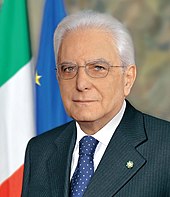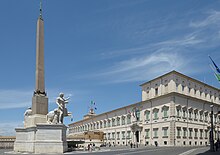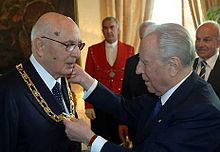President of the Italian Republic
|
President of the Italian Republic |
|

|
|
| Standard of the President | |

|
|
|
Acting President Sergio Mattarella since February 3, 2015 |
|
| official seat | Quirinale Palace |
| tenure | 7 years (re-election possible immediately and in unlimited numbers) |
| creation of the office | January 1, 1948 |
| last choice | January 29, 2022 |
| deputy | President of the Italian Senate |
| website | www.quirinale.it |

The President of the Republic (Italian Presidente della Repubblica ) is the head of state of the Italian Republic . He is elected by Parliament and representatives of the regions for a seven-year term.
The role of the President of the Republic is described in Articles 82 to 91 of the Constitution of the Republic. Alongside the parliament, the government and the constitutional court , it is one of the supreme constitutional bodies . He does not belong to any of the three state powers , but embodies the unity of the republic as a power sui generis and as an organ super partes ; he monitors and ensures the correct interaction of the constitutional organs within the framework of the separation of powers . In the order of protocol , he is in first place, ahead of the Presidents of the two chambers of Parliament. Politically far more important, however, is the prime minister as head of government .
The official residence of the President is the Quirinale Palace in Rome . Acting President of the Italian Republic is Sergio Mattarella .
Historical background
After the end of fascism and the Second World War , a referendum on the form of government and the election of a Constituent Assembly took place in Italy on June 2nd and 3rd, 1946 . A narrow majority of those entitled to vote spoke out in favor of the republic and thus against the previous monarchy . The last king of Italy , Umberto II , had to leave the country with his family. Until 2002 his descendants had to remain in exile . The royal house of Savoy also lost large parts of its property to the new republic.
Prime Minister Alcide De Gasperi briefly assumed the duties of Head of State in June 1946 until the Constituent Assembly elected Enrico De Nicola as interim Head of State at the end of the month. By December 1947, the Assembly was drafting a new constitution , which came into effect on January 1, 1948. This provided for a president who, as in other systems of parliamentary democracy, forms a kind of "king substitute".
On this basis, on April 18, 1948, the first parliament of the Italian Republic was elected, which then, on May 11, 1948, elected the President of the Republic, as provided for by the Constitution. On January 1, 1948, Enrico De Nicola became the first president on the basis of a transitional provision in the constitution and remained so until the elections in May 1948. With a few exceptions, his successors each stayed in office for seven years.
duties and powers
The role of the president is not definitively regulated in the constitution. He has extensive duties and powers vis-à-vis the executive as well as the legislative and judiciary . However, the limited day-to-day political role that the head of state has in parliamentary democracies becomes apparent through the largely symbolic tasks; where the President would theoretically have powerful powers, prior authorization by Parliament or ministerial countersignature is most often required.
The President of the Republic confers the awards of the Italian Republic. He is Grand Master or Chief of the Order of Merit of the Italian Republic , the Military Order of Italy and other orders.
Head of State and Foreign Policy
The President is the symbol of the unity of the Republic, which he represents as Head of State in international affairs. He receives representatives of foreign states; all international treaties are to be approved and promulgated by him if he has been authorized to do so by Parliament.
The President of the Republic chairs the Supreme Defense Council and is the Commander-in-Chief of the Armed Forces . As long as there is no direct external or internal threat to the existence of the republic and its constitutional order, the supreme command is of a representative nature. In constitutional reality, the parliament and the government set the guidelines for defense policy. The President declares the state of war decided by Parliament.
Government Formation and Crisis
The President appoints the Prime Minister and, on his recommendation, the ministers . When it comes to appointing the prime minister, the president is not bound by any stipulations from a purely constitutional point of view. However, over the decades, customary constitutional law has become established, forcing the President to take account of majorities in Parliament, as the government depends on the confidence of both houses of Parliament. The government determines the guidelines for politics, the role of the President lies outside of day-to-day politics.
The President accepts oaths and any resignations from cabinet members. In cases where this is provided for, he appoints senior officials and officers .
Opposite the chambers
The President can dissolve Parliament (one chamber or both) and call early elections . This usually only happens when parliament cannot fulfill its constitutional duties or the formation of a government fails. He may not exercise this power in the last six months of his mandate unless they coincide in whole or in part with the last six months of Parliament's legislature. He has the right to appoint five senators for life . What this means in concrete terms, i.e. five appointments per president or five senators in total, is disputed in legal theory. In practice, this has been handled differently by different Presidents.
The President, by his signature, issues and promulgates laws passed by Parliament and acts having the force of law issued by the Government (the latter are first countersigned by the President of the Council of Ministers). In the case of laws, he has a one-time suspensive right of veto . If Parliament re-enacts a rejected law, he must sign it. He can address messages to the chambers of parliament.
In the cases envisaged by the Constitution, the President shall order the holding of referendums or referendums , provided that the Constitutional Court has previously decided on the admissibility of the subject and the Court of Cassation on the fulfillment of the requirements (validity and number of signatures collected).
Every President of the Republic is entitled to a lifetime senator post after the end of his term of office, but may renounce it.
criminal and administrative law
He has the right to pardon .
jurisdiction
The President appoints five out of 15 constitutional judges. He is the Chairman of the Supreme Council of the Judiciary , the self-governing body of judges and prosecutors of the ordinary courts .
Legal status of the President
The office of President is incompatible with any other office, paid or unpaid. The President enjoys immunity for all actions taken in the exercise of his office . However, this does not apply to high treason or breach of the constitution . In both cases he will be indicted by Parliament in a joint session. Both chambers of parliament can then, with an absolute majority of their members, decide to bring charges before the constitutional court.
Legal acts of the President usually require the countersignature of the Prime Minister or a minister. As a result, members of the government assume responsibility for the President's actions.
Election, oath of office and assumption of office
The President of the Republic is elected by the two Chambers of Parliament ( parlamento in seduta comune , consisting of the Chamber of Deputies and the Senate ), which meet in joint session, and representatives of the 20 regions : three per region, with the exception of Valle d'Aosta , which may only send one representative. The President is elected by secret ballot with a two-thirds majority of the Assembly. After the third ballot, an absolute majority is sufficient. All Italian citizens who have reached the age of fifty and who are in full possession of their civil and political rights are eligible for this office. The regular term of office of the President is seven years. The Constitution contains no express limitation on the incumbent's re-election for one or more additional terms.
Until 2022, the only re-elected president was Giorgio Napolitano , who resigned in his second term on January 14, 2015 at the age of 89 . In April 2013, at the request of the parties, he broke the Republican tradition of a single term because Parliament could not agree on a successor. After Napolitano announced that he would only remain in office for as long as absolutely necessary, he resigned after the end of the Italian EU Council Presidency . On January 29, 2022, Sergio Mattarella, who initially did not stand for re-election, was re-elected to a second term after none of the proposed candidates obtained the required majority in the previous seven ballots.
The President-elect takes the following oath of office before the deputies, senators and representatives of the regions in the plenary hall of the Chamber of Deputies in the Palazzo Montecitorio , in accordance with Article 91 of the Constitution : "I swear to be faithful to the Republic and to faithfully follow its Constitution." (Giuro di essere fedele alla Republica e di osservarne lealmente la Costituzione) . This is followed by the 21 gun salutes , the ringing of the big bell on the Palazzo Montecitorio and the President's inaugural speech in the plenary hall, which is only decorated with Italian flags on this occasion . The President is then driven to the Quirinal Palace, where he formally takes over official business. On the way, the Mayor of Rome greets him at the Vittoriano , where a wreath-laying ceremony takes place at the Tomb of the Unknown Soldier.
Representation and end of term
The powers of the President of the Republic are temporarily taken over by the President of the Senate, who is then unofficially known as Presidente supplente della Repubblica or " Supplierender President of the Republic". In the event of permanent impediment, resignation or death, the Assembly shall convene no later than 15 days from the date of termination of the term of office to elect a new President. The Assembly is convened by the President of the Chamber of Deputies. If both chambers of parliament have been dissolved or if there are less than three months until the end of the electoral period, the deadline provided for this case applies.
Former presidents (“old presidents”) are called Presidente emerito della Repubblica or “ President Emeritus of the Republic” in Italy. After the end of their term of office, Presidents are automatically senators for life , unless they waive it. As senators for life, they are entitled to an office at the seat of the Senate President in the Palazzo Giustiniani . The incumbent president can seek advice from the past presidents. This usually happens when governments are formed.
Official residence and official insignia
The President's official residence is in the Quirinal Palace in Rome . In addition, he has a country estate in Castelporziano near Rome and the Villa Rosebery near Naples .
The Great Chain of Orders (Gran Cordone) of the Order of Merit of the Italian Republic is an official insignia of the President. She is generally only seen at the handing over of office at the Quirinal Palace. Otherwise, the President usually wears the corresponding rosette on the left lapel of the suit jacket.
The President's standard is a blue-rimmed square. Blue was the color of the Kingdom of Sardinia-Piedmont , which became the Kingdom of Italy in 1861 . The further design in the national colors of Italy refers to Napoleonic Italy from 1802 to 1814. The emblem of the Italian Republic, which has existed since 1946, can be seen in the middle.
The Past Presidents carry a similar, somewhat simplified standard with the monogram RI (Repubblica Italiana) under a mural crown . If the President of the Senate temporarily assumes the functions of President of the Republic for the reasons mentioned, the President of the Senate also carries a standard on which the emblem of the Republic can be seen on a white background and a blue border.
List of Presidents
| # | image | Surname | ballot | taking office | resignation | Political party |
|---|---|---|---|---|---|---|
| − |

|
Alcide De Gasperi 1 | − | June 12, 1946 | July 1, 1946 | DC |
| 1 |

|
Enrico DeNicola 2 | 1 | July 1, 1946 | May 12, 1948 | PLI |
| 2 |

|
Luigi Einaudi | 4 | May 12, 1948 | May 11, 1955 | PLI |
| 3 |

|
Giovanni Gronchi | 4 | May 11, 1955 | May 11, 1962 | DC |
| 4 |

|
Antonio Segni | 9 | May 11, 1962 | December 6, 1964 3 | DC |
| 5 |

|
Giuseppe Saragat | 21 | December 29, 1964 | December 29, 1971 | PSDI |
| 6 |

|
Giovanni Leone | 23 | December 29, 1971 | June 15, 1978 3 | DC |
| 7 |

|
Sandro Pertini | 16 | July 9, 1978 | June 29, 1985 | PSI |
| 8th |

|
Francesco Cossiga | 1 | July 3, 1985 | April 28, 1992 | DC |
| 9 |

|
Oscar Luigi Scalfaro | 16 | May 28, 1992 | May 15, 1999 | DC / Independent |
| 10 |

|
Carlo Azeglio Ciampi | 1 | May 18, 1999 | May 15, 2006 | independent |
| 11 |

|
Giorgio Napolitano | 4 | May 15, 2006 | April 22, 2013 3 | DS / Independent |
| 6 | April 22, 2013 | January 14, 2015 3 | ||||
| 12 |

|
Sergio Mattarella | 4 | February 3, 2015 | officiating | PD |
| 8th | chosen | |||||
Others
The official salary of the Italian President amounts to around 240,000 euros a year. Any pension payments are taken into account, so they cannot be accumulated.
The President has a relatively small private apartment in the Quirinale Palace. Otherwise, the palace is used for official purposes or as a museum.
The President has his own bodyguard , the Corazzieri , who also protect his official residence and take part in receptions with military honours . On ceremonial occasions , Corazzieri , on horseback or motorbikes, escort the state carriage of the President or other heads of state who are on a state visit to Italy.
means of travel
Various means of travel are available to the President for official purposes. In 1961 the Quirinal received four Lancia Flaminia 335 Presidentiale landaulets , two of which are still used on special occasions. No vehicle license plates deviating from the standard are issued for these vintage cars and also for the modern special protection vehicles . Armored Maserati Quattroporte of the sixth generation are currently being used.
In 1948, after renovation work, the Italian Republic took over the royal court procession as the presidential procession. The train maintained by the FS Foundation is still available, but has hardly been used by the Presidents in recent decades. It is located in the saloon train depot at Rome-Termini main station , where guided tours are offered irregularly. A saloon car of the train is in the Pietrarsa Railway Museum near Naples.
The President of the Republic can use a boat from the Italian Navy or from the security authorities for official needs. The small presidential yacht Argo was decommissioned in 2020 and has not been replaced.
Planes and helicopters from the 31st Squadron of the Italian Air Force are ready for further trips.
Fiat 2800 , used until 1961
Lancia Thesis , 2007
Flaminia Presidential, June 2, 2008
Lancia Theme , 2016
Presidential train saloon car
See also
web links
- Official website of the President of the Italian Republic
- Italian Constitution (in Italian and German text)
- List of heads of state and government of Italy at worldstatesmen.org
Remarks
- ↑ The so-called "white semester" is intended to prevent the president from attempting to influence his possible re-election or at least his successor by dissolving parliament and holding new elections towards the end of his term of office. (Art. 88) Semestre bianco on treccani.it
-
↑ The Constitution does not explicitly grant the President the right to refuse to sign government-issued decrees (which must be ratified by Parliament) or statutory decrees (which are based on an authorization by Parliament signed by the President). In a few cases, the signature was refused because the government decrees violated the principles of the constitution and its spirit. According to one legal opinion, in these cases the President makes use of his preventive examination competence with regard to constitutionality (vs. subsequent examination by the constitutional court).
Prof. Antonino Spadaro: Può il Presidente della Republica rifuitarsi di emanare un decreto-legge? Le “ragioni” di Napolitano . - ↑ Sergio Mattarella re-elected President of Italy
- ↑ Details on the procedure on ilfattoquotidiano.it , February 3, 2015.
- ↑ Standards of the Italian Heads of State since 1861
- ↑ La Stampa, May 17, 2015
- ↑ Two went to museums in Turin and Rome , the existence of a fifth vehicle in the small series is disputed. Corriere della Sera, November 18, 2014
- ↑ fondazionefs.it - La collezione di Pietrarsa
- ↑ Città della Spezia (CDS News), February 15, 2020









